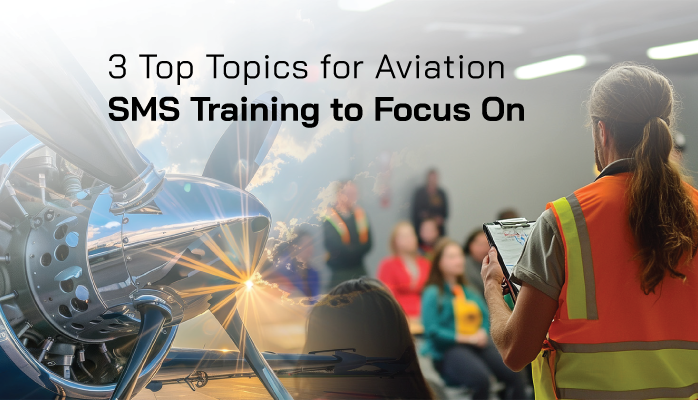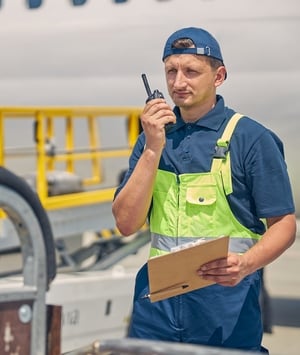Reduce Resistance to Change Through Aviation SMS Training Courses

Reducing resistance to change in aviation safety management systems (SMS) is not often associated with safety training. But when safety managers know the right topics for aviation SMS training and pursue those topics effectively, a natural consequence is:
- A more transparent safety culture;
- Increased safety reporting metrics;
- Improved safety culture;
- More effective operational processes;
- More efficient and manageable aviation risk management processes;
- More effective proactive risk management in the SMS; and
- Larger data sets to use in predictive risk management processes.
Related Aviation SMS Training Articles
- When Employees Need More Hazard Identification Training - Aviation SMS
- What Is Aviation Safety Training in Aviation SMS - Includes Videos to Use
- How to Automate Aviation SMS Training in 4 Steps Using Your Safety Program
Here are 3 critical training topics in aviation SMS that managers should focus on.
1 – Safety Communication
Communication is the foundation of every relationship.
Organizations with adaptable and proactive risk management processes have excellent communication channels. Communication is an essential part of safety managers' role as a manager and/or leaders to facilitate strong communication as a means of driving aviation SMS performance.
Communication in aviation SMS can be:
- Formal: such as with
- safety communication technology tools;
- risk management workflow tools;
- safety reporting tools, etc.; or
- Informal: such as how comfortable employees are speaking openly with each other.

Aviation SMS training focusing on communication can happen on both levels. Training employees to be extremely comfortable with safety reporting procedures, and safety communication technology tools are one essential area of formal training. Don’t assume that because the communication technology tools are available employees are comfortable using them.
Formal SMS training for communication tools should be an initial and recurring requirement. The ability for employees to be comfortable with formal tools can be the difference between being effectively engaged and not being engaged in communication aspects of the SMS.
Training is also essential for informal communication. Such training can be on
- effective communication techniques for feedback;
- asking questions;
- confidence in dealing with customers;
- dealing with difficult people;
- managing frustration;
- listening skills;
- empathy training;
- stress management, etc.
Learning about how to more effectively communicate will empower employees at all levels of an organization to be more transparent and develop a healthy safety culture. Furthermore, when these employees have customer-facing positions, communications training presents two favorable benefits: one for improved operations, and the other for building a safety culture.
Since communications training benefits operations, safety managers may discover creative ways to share training budgets that create a win-win for both departments.
Related Aviation SMS Training Articles
- Why Employees Can’t Stand Aviation SMS Training
- 6 Tips to Improve Aviation SMS Training Courses
- 4 Pillars | 10 Things You Need to Know About Aviation Safety Training
2 – Accountabilities
Assessing and reassessing aviation SMS safety accountabilities is vital for organizations for several reasons:
- Help keep out “holes” in the risk management process (i.e., the Swiss Cheese Model);
- Prevent audit findings; and
- Easier proactive risk management process by ensuring that bureaucratic procedures closely match real-life practices.
Moreover, ensuring that an organization has strong accountabilities ensures that employees are well-trained in the limitations of their duties. It can help reduce extremely poor risk management practices in aviation SMS. One common scenario is an employee or manager who is fearful of losing his job and:
- Does not share safety information;
- Provides superficial safety training;
- Tries to be “indispensable” to their organization.
This is a great example of how a lack of safety accountability training and enforcement allows employees to overstep their boundaries and makes it difficult for safety managers to count on various roles in the SMS. In effect, risk management processes will not function as they are supposed to.
3 – Full Aviation Risk Management Cycle
The aviation risk management cycle starts with hazard identification and safety reporting. During employees, customers, and other stakeholders’ interactions in your organization's environment, they often identify whether a potential risk exists. Most will report hazards, accidents, or irregularities using formal hazard reporting tools.
Most aviation service providers today have simple, user-friendly safety reporting systems that minimize resistance, from the reporters' perspective to receiving these "reported issues." However, employees need to be able to understand and track what happens to reported safety issues during the full process. This will include hazard identification training that educates the "primary system observers."
These "System Observers" are monitoring the company's many "systems." System observers must understand what are:
- systems' hazards;
- hazard-related consequences should a hazard not be controlled; and
- existing risk controls to mitigate risk, and how to interact with these controls when necessary.
Understanding the full aviation risk management cycle is extremely important for informing reporters to comprehend:
- The kind of information that is helpful when reporting;
- The kinds of hazards and irregularities that are of the greatest concern; and
- How the reporters' safety issues come full circle to influence change.
The last point is critical. A natural result of understanding the aviation risk management cycle is that employees can see and feel involved in aviation change management. They can see change as a result of their actions rather than management imposition.
As employees see that their hazard identification and safety reporting activities improve systems' processes and operational safety assurance, the employee assumes a sense of ownership and responsibility. They will be more inclined to protect a system where they have ownership. Safety cultures that have engaged employees
Related Aviation SMS Training Articles
- Safety Chart: How Effective Is Hazard Identification Training in Aviation SMS?
- Best Ways to Automate Aviation Safety Training for Initial/Recurrent Requirements (Free Resources)
- 5 Signs of Good Aviation Risk Management Training
Final Thought: Make Training Interesting
Consider one of the most successful educational resources open to the public: TED Talks. One of the reasons this educational channel has become so wildly successful is they invite speakers who make education interesting and entertaining.
Yet most of us – especially in the aviation industry - are used to dry, technical, safety training courses that make us feel like we’re back in driver’s ed. again.
There is no reason that aviation SMS training has to be boring.
It can be interesting, interactive, have incentives, and be the kind of training that makes information stick in employees' minds long afterward. And while you are creating your fun, interesting training, keep in mind that this training significantly affects:
- Hazard identification effectiveness;
- Safety reporting metrics; and
- Safety culture.
Ultimately, the course material used in safety training is only as good as how that information is delivered. Managers should therefore concentrate on making hazard identification and safety training at least as interesting as it is informative.
Free SMS Hazard Identification and Safety Training Resource
This is one excellent safety training and safety promotion resource. Download your safety poster today!
Last updated January 2025.








